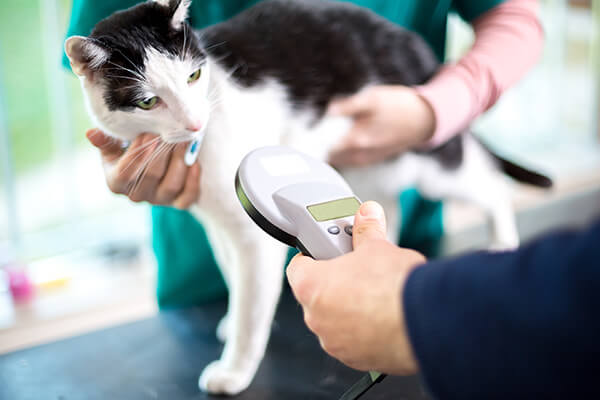Benefits of microchipping your pet
The primary benefit of using a microchip is that if an animal is lost or stolen, they can be identified and traced back to an owner when they are recovered, and in the care of a veterinarian or shelter.
Did you know that statistically, one in three pets may become lost or go missing in their lifetime. Having a collar with an ID tag is a good measure to have. The downside, however, is that collars can break or be taken off, and in that case will do little to help identify an animal that has been found. If your pet is lost or stolen and then recovered and is taken to an animal shelter or veterinarian, they will be able to scan your pet’s unique ID. This is the number that will be used to identify the pet along with your contact information, and ultimately reunite you with your pet.
Another big reason is if you are planning on traveling with your pet internationally. If you are traveling to an EU Country and many other countries in the world, a microchip for your dog or cat is mandatory as veterinary officials use it to compare your pet that they are scanning to the veterinary documents you have presented. At Glen Oak we use international chips by Avid that can be used for international travel.
What Is a Microchip?
A pet microchip is a radio-frequency identification (
Is It Safe?
It is important to note that these devices are biocompatible. That means they are not toxic to your pet and should not cause an allergic reaction. The microchip does not transmit any information. It will only provide the ID when actively scanned. The microchip is non-mechanical and does not contain a battery or need an external power source.

How do I get my pet microchipped?
A veterinarian will use a hypodermic needle to implant the microchip. This is no more painful or invasive than any routine vaccination shot. The long term benefits of a microchip can far outweigh the temporary discomfort your pet may feel during implantation. The procedure for getting a microchip implant takes only about five minutes. The microchip is injected under the loose skin between your pet’s shoulder blades. Each unique microchip is associated with a registration number which is registered in a national database.
*NOTE. It is important that your pet is registered with a national database. Just having the implanted microchip is not effective if there is no information for the unique ID to cross-referenced. Organizations such as Avid, AKCCAR and HomeAgain maintain databases of pets who are microchipped. Before implanting a microchip, your vet will use a microchip scanner to ensure the animal doesn’t already have an existing chip implanted. It is not uncommon for animals that are given or sold to new owners and the information of the microchip is not updated. Important note to owners who received pets from a shelter. Change the registration to your information from that of the shelters once you have them.
How much does it cost
The typical microchip procedure costs between $25 and $75 (in addition to registration fees). Pricing will vary between individual veterinarian practices. Most would agree that the nominal cost of getting a microchip is well worth the increased the chance of being successfully reunited with missing or stolen pet. According to AKC Reunite, “Pets with microchips are up to 20 times more likely to be reunited with their owners.”
Other things to keep in mind:
- It Not a GPS tracker: A microchip itself cannot track your dog’s location.
- Microchip with updated contact information: Make sure to keep the contact information associated with your dog’s microchip up to date.
- Collar and ID tag are still important: Even with a microchip, it’s important for your dog to wear a collar with an ID tag that includes your contact information.
Overall, microchipping is a safe and effective way to increase the chances of being reunited with your cat or dog if they get lost or stolen. Vets strongly recommend microchipping for all companions.
For More information See:
The American Veterinary Medical Association: Microchipping FAQ


